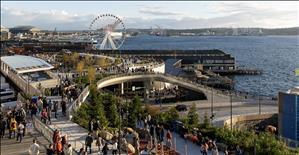Seattle’s waterfront is a place where people have been gathering, trading, and playing for centuries, even as the actual ground beneath it has changed from tidelands to dry land and the vessels plying the waters have grown from canoes to post-Panamax (and, soon, super-post-Panamax) cargo ships. The changing landscape at first reflected the changing needs of the shipping industry. Canoes could easily land anywhere along the beach, but sailing ships and then steamships needed piers to span the distance between the shoreline and deep water. To move cargo over land, railroads needed access to the piers, but downtown’s steep hills limited them routes running parallel to the shore. The tension between north-south cargo movement and east-west people movement, amplified by the addition of a seawall, the vehicular route, Alaskan Way, and the elevated highway, the Alaskan Way Viaduct, shaped the character of the waterfront. With the removal of the Alaskan Way Viaduct and realignment of Alaskan Way underway, the waterfront is again transforming, this time incorporating recreation and care of the environment.
To take this walking tour, visit HistoryLink.Tours.

